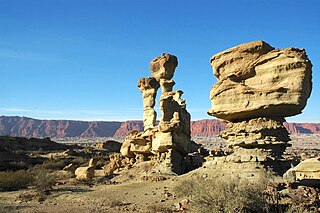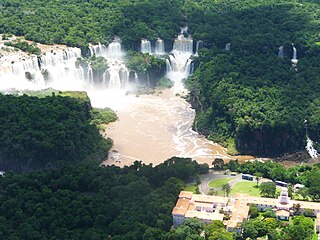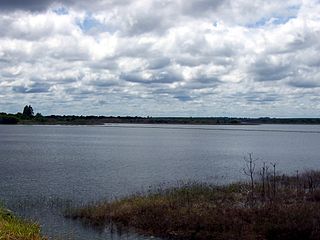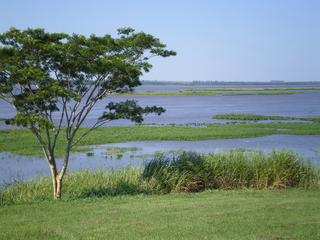
The Iguazú National Park is a national park of Argentina, located in the Iguazú Department, in the north of the province of Misiones, Argentine Mesopotamia. It has an area of 677 km2 (261 sq mi).

A provincial park is a park administered by one of the provinces of a country, as opposed to a national park. They are similar to state parks in other countries. They are typically open to the public for recreation. Their environment may be more or less strictly protected.

The Ilha Grande National Park is located on the border between Paraná and Mato Grosso do Sul states in Brazil. The park was created in 1997 to protect the biological diversity of the upper Parana River area.

San Pedro Department is the largest and most sparsely populated department in the Misiones Province, Argentina. It covers an area of 3407 square kilometres and has a population of 24,000 people. San Pedro includes part of the Paraná River watershed, part of the Uruguay River watershed, and the Sierra Central that divides these two systems.
San Pedro (Misiones) is a village and municipality in Misiones Province in north-eastern Argentina.

The Mico Leão Preto Ecological Station is an Ecological station in the state of São Paulo, Brazil. It protects four fragments of Atlantic Forest in a region that has lost most of its forest coverage over the last century, and protects the endemic endangered black lion tamarin, which gives the reserve its name.

The Morro do Diabo State Park is a state park in the state of São Paulo, Brazil. It protects an area of Atlantic Forest in a region that has lost most of its forest coverage over the last century, and protects the endemic endangered black lion tamarin

The Trinational Biodiversity Corridor is a proposed ecological corridor that would link protected areas in the Alto Paraná Atlantic forests ecoregion in Brazil, Paraguay and Argentina.

The Aguapeí State Park is a state park in the state of São Paulo, Brazil. It protects an area of floodplain in the Atlantic Forest biome, home to many water birds.
The Urugua-í Provincial Park is a Provincial park in the Misiones Province in the northeast of Argentina. It protects an area of Alto Paraná Atlantic forests in the upper basin of the Urugua-í River.

The Urugua-í River is a river in the Misiones Province of Argentina. It is a tributary of the Paraná River.

The Mbaracayú Forest Nature Reserve is a protected area in Paraguay.
The Valle del Arroyo Cuña-Pirú Reserve is a private nature reserve in the Misiones Province of Argentina.
The Papel Misionero Natural Cultural Reserve is a natural cultural reserve in the Misiones Province of Argentina.
The Iguazú National Reserve is a national reserve in the Misiones Province of northeastern Argentina.

The Rio do Peixe State Park is a state park in the state of São Paulo, Brazil.

The Lagoa São Paulo Reserve is an ecological reserve in the state of São Paulo, Brazil. It was created in 1942, but over the years suffered considerable degradation by illegal invasions and squatters. It was largely flooded after construction of the Eng Sérgio Motta Dam on the Paraná River. Only a small part of the original reserve remains, but some efforts are being made to restore it.

The Great Pontal Reserve, formally called the Pontal do Paranapanema State Reserve, is an ecological reserve is the state of São Paulo, Brazil. It was created in 1942, but over the years suffered considerable degradation by illegal invasions and squatters. It was partly flooded after construction of the Eng Sérgio Motta Dam on the Paraná River. The reserve today is a poor agricultural region mostly used for cattle and sugar cane farming.

The Rio Ivinhema State Park is a State park in the state of Mato Grosso do Sul, Brazil.
This page is based on this
Wikipedia article Text is available under the
CC BY-SA 4.0 license; additional terms may apply.
Images, videos and audio are available under their respective licenses.













